Interstellar Comet 3I ATLAS Latest News and General Information
This year, we’re welcoming a rare guest in our skies – the interstellar comet 3I/ATLAS! It’s only the third interstellar object ever discovered, making it a once-in-a-lifetime visitor. But some argue we shouldn’t dismiss a wilder possibility: could it be an alien probe passing through our Solar System? Whatever you believe, you can track 3I/ATLAS in the Sky Tonight app. After spending weeks hidden behind the Sun, the comet is now returning to view in the morning sky. Learn when and how to see it, and plan your perfect observing moment!
Contents
- What is 3I/ATLAS?
Comet 3I ATLAS latest news: does 3I ATLAS have a tail?
- December 1: New 3I/ATLAS images suggest it may be covered in ‘ice volcanoes’
- December 1: Is 3I/ATLAS pulsing like a ‘heartbeat’?
- November 25: International Asteroid Warning Network will keep an eye on 3I/ATLAS. Why?
- November 20: NASA posted the long-awaited 3I/ATLAS photos
- November 18: New 3I/ATLAS images by amateur photographers
- November 17: NASA is soon to share the long-awaited comet 3I/ATLAS images
- November 16: Watch 3I/ATLAS livestream as it speeds away from the Sun
- November 11: Did 3I/ATLAS break apart near the Sun?
- November 11: Cosmic rays may have “cooked” 3I/ATLAS for millions of years
- November 10: Comet 3I/ATLAS has sent a radio signal
- November 10: 3I ATLAS grows prominent tails
- November 5: Did 3I ATLAS change course?
- November 4: 3I ATLAS color change puzzles scientists
- November 2: 3I/ATLAS is coming back into view
- October 29: 3I/ATLAS survives its close pass to the Sun, suddenly brightening
- 3I ATLAS news recap: September-late October 2025
- Comet 3I ATLAS live tracking: where is 3I ATLAS now, and how to see it
- Frequently asked questions about the comet 3I/ATLAS
- 31 ATLAS, 3AI ATLAS, ATLAS 3I, 3 Eye Atlas: what’s the correct name?
- Comet 3I/ATLAS discovery
- Comet 3I/ATLAS: to sum up
What is 3I/ATLAS?
3I/ATLAS is the third known interstellar object — a rare visitor from beyond our Solar System. It was first spotted on July 1, 2025, by the ATLAS survey telescope in Chile. The official view, supported by NASA, ESA, and most astronomers, is straightforward: 3I/ATLAS is a natural comet — the third interstellar object ever confirmed, after ‘Oumuamua and comet 2I/Borisov. But not everyone is convinced, and some argue that its unusual properties leave room for more exotic explanations.
Is 3I/ATLAS an alien ship or a comet? Harvard professor vs scientific community
Ever since its discovery, Harvard astronomer Avi Loeb has questioned whether 3I/ATLAS is a normal comet at all. He points to its unusual brightness, precise path through the Solar System, and lack of clear cometary outgassing early on — arguing that it doesn’t behave like a comet. In later updates, Loeb noted its unexpected stability and high mass, speculating that if the object ever changed course near the Sun, this could hint at technological propulsion rather than natural forces. He even joked that people should “take their vacation before October 29,” when the comet reaches perihelion — in case it’s something far stranger than expected.
Most astronomers, however, are unconvinced. Observations from Hubble, SPHEREx, and ESA’s Mars orbiters show signs of a classic comet: a small icy nucleus, a carbon-dioxide-rich coma, bursts of water vapor, and even a rare anti-tail caused by viewing geometry. The evidence shows that 3I/ATLAS is a remarkable natural comet, now giving scientists an unprecedented look at the chemistry of interstellar objects.
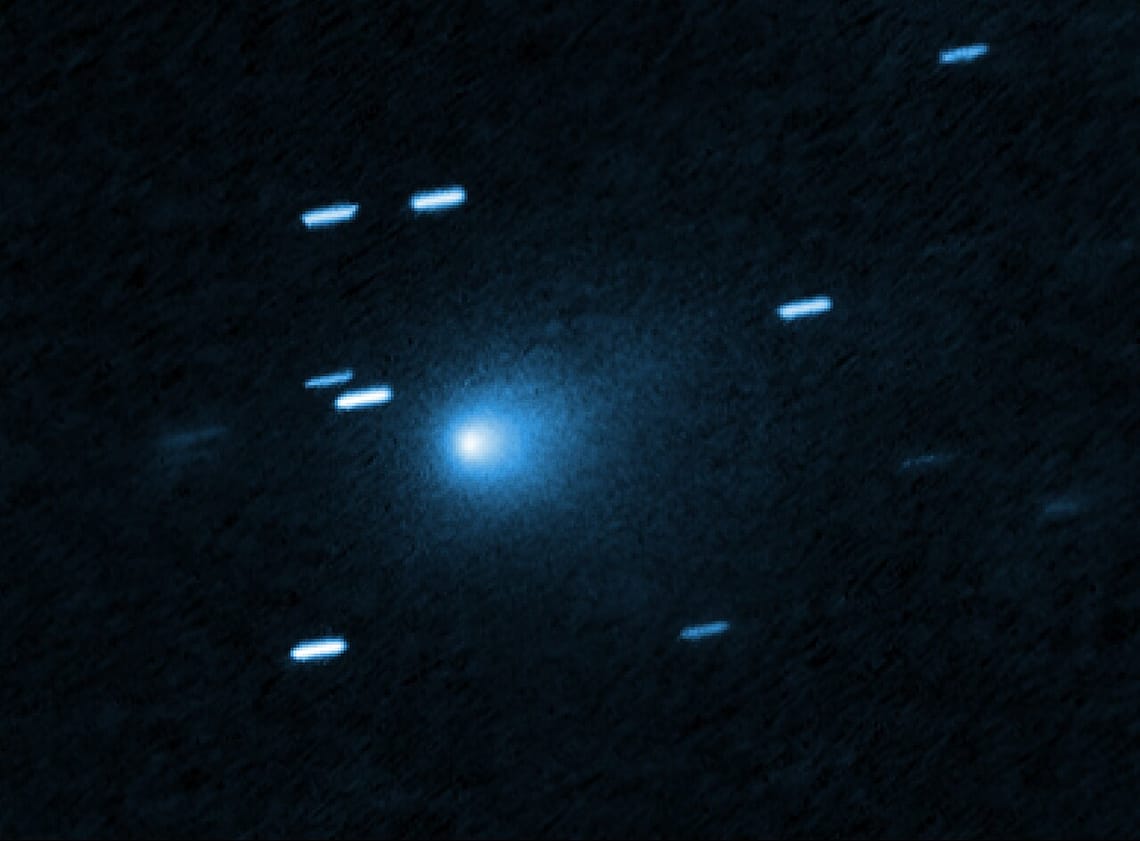
Comet 3I ATLAS latest news: does 3I ATLAS have a tail?
So much has happened since the interstellar comet 3I/ATLAS burst onto the scene that it’s easy to lose track. Has it changed color again? Shifted course? Survived its close brush with the Sun? Here’s everything we know so far about what’s happening with this mysterious visitor from another star system.
December 1: New 3I/ATLAS images suggest it may be covered in ‘ice volcanoes’
New images of interstellar comet 3I/ATLAS have revealed something spectacular: spiraling jets bursting from its surface. Some astronomers think these could be cryovolcanoes – ‘ice volcanoes’ that shoot gas and dust into space as the comet warms near the Sun.
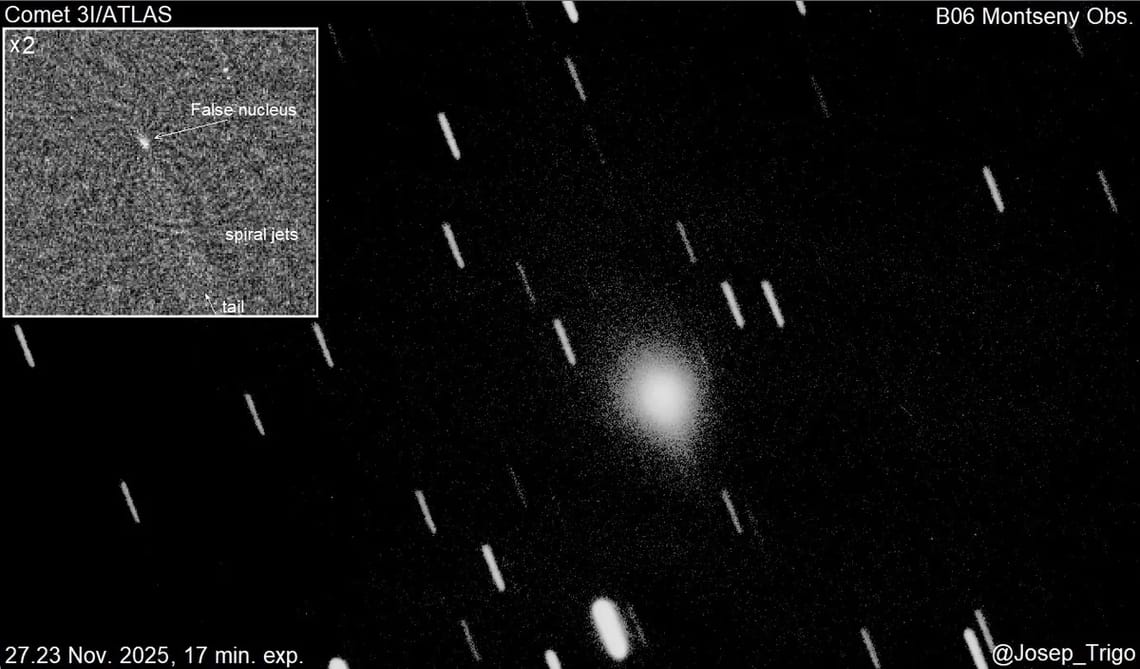
The idea still needs to be confirmed, but if it holds up, 3I/ATLAS may be very different from the comets we’re used to. In fact, it may have more in common with the icy worlds of the outer Solar System – like Pluto or Triton – than with typical comets we see closer to home.
December 1: Is 3I/ATLAS pulsing like a ‘heartbeat’?
Harvard astronomer Avi Loeb, who has been pointing out oddities in 3I/ATLAS since the day it was discovered, now notes another one: the comet’s brightness seems to rise and fall every 16 hours. Normally, such variations could be explained by a rotating nucleus – but in this case, almost all the light we see comes from the coma, not the nucleus, so the usual explanation doesn’t quite work.
Loeb suggests another possibility: the comet’s jets may be firing in pulses, creating a repeating ‘heartbeat’ pattern. Each burst of gas and dust makes the coma flare up, then fade, then flare again. This could still be natural – for example, a volatile patch on the surface releasing gas once per rotation. But Loeb points out that if the jets don’t always aim toward the Sun, or if their timing seems too precise, it starts looking less ‘comet-like’ and more... unnatural. In that case, he argues, we may be seeing signs of an artificial mechanism with a controlled exhaust system.
For now, it’s just another mystery, and astronomers are racing to capture more data to figure it out.
November 25: International Asteroid Warning Network will keep an eye on 3I/ATLAS. Why?
The International Asteroid Warning Network (IAWN) has announced its special comet astrometry campaign for 3I/ATLAS that will last from November 27, 2025, through January 27, 2026. IAWN is the same organization that tracks potentially hazardous asteroids and even published an alert earlier this year when asteroid 2024 YR4 appeared to be on a collision course with Earth. So when people saw IAWN and 3I/ATLAS in one sentence, some immediately tensed up. So, should we worry?
Short answer: no. The campaign isn’t a secret crisis meeting. It’s basically a global training exercise for astronomers: a chance to practice precise comet tracking, compare techniques, and coordinate observations. 3I/ATLAS is a perfect test subject because it’s rare, fast, faint, and currently sitting in a good patch of sky for astrometry.
3I/ATLAS is absolutely harmless: its closest distance to Earth is ~270 million km — almost twice the Earth–Sun distance. There are zero scenarios where it suddenly swings toward us. Anyway, it’s good to know the team that protects Earth from real threats stays in practice.
November 20: NASA posted the long-awaited 3I/ATLAS photos
NASA has finally unveiled the long-anticipated images of interstellar comet 3I/ATLAS, taken during its close flyby of Mars in early October — a release delayed for weeks by the U.S. government shutdown.
The highlight of the update is a new set of observations from the Mars Reconnaissance Orbiter, which captured the comet as it passed about 30 million kilometers (0.19 AU) from the Red Planet.
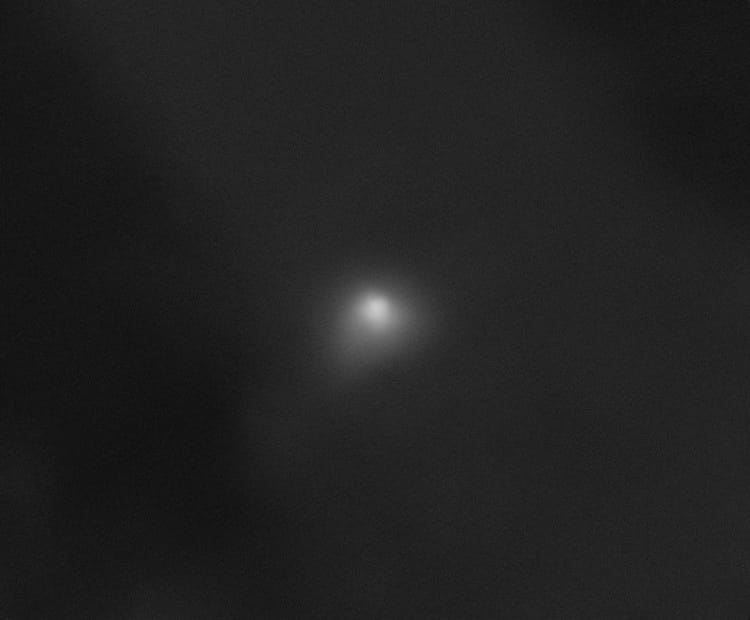
In addition to Mars-based assets, NASA emphasized that solar and asteroid-mission spacecraft were also watching 3I/ATLAS. Instruments aboard SOHO, STEREO-A, PUNCH, Lucy, and Psyche contributed complementary perspectives, offering a multi-angle look at the comet’s activity as it interacted with the solar wind and brightened near perihelion.
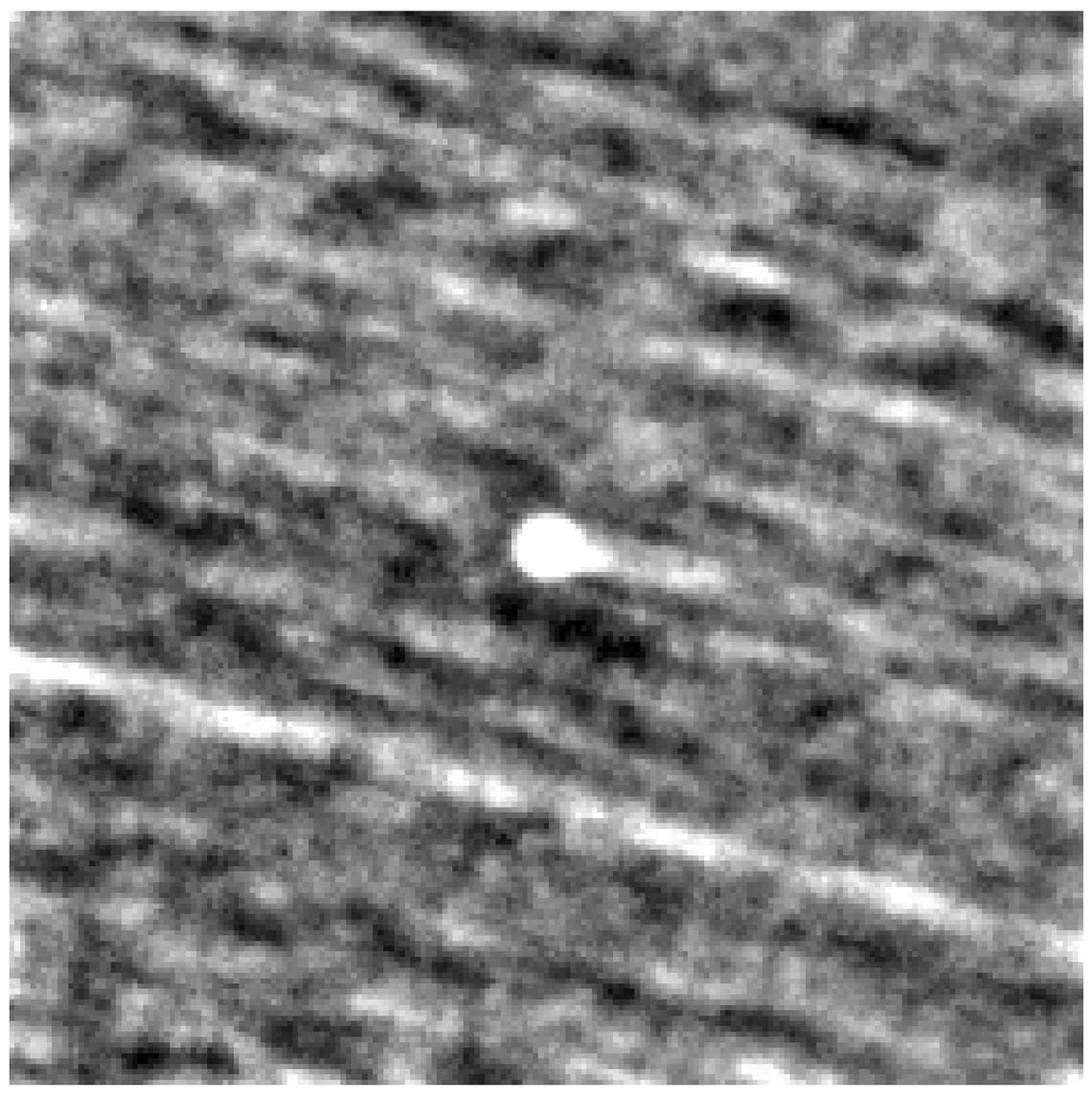
NASA’s full write-up, with images and mission-by-mission details, is available in their official blog post.
November 18: New 3I/ATLAS images by amateur photographers

The interstellar comet 3I/ATLAS is finally emerging from behind the Sun and can now be seen again in dark skies. As it drifts farther from the Sun — both in space and in apparent distance — the first sharp new images are starting to roll in.
Astrophotographer Satoru Murata has released a detailed photo showing the comet’s complex gas tail structure and even a hint of a forming dust tail. A faint false anti-tail can also be spotted. Around the same time, Francois Kugel captured another impressive image, revealing a similar level of detail.

November 17: NASA is soon to share the long-awaited comet 3I/ATLAS images
With the U.S. government shutdown finally over, NASA announced that it will reveal high-resolution images of 3I/ATLAS taken by the Mars Reconnaissance Orbiter during the comet’s close pass by Mars in early October. The long-awaited NASA live image viewing event is scheduled for Wednesday, November 19, at 20:00 GMT (3 p.m. EST), promising never-before-seen shots of our interstellar visitor. Stay tuned!
November 16: Watch 3I/ATLAS livestream as it speeds away from the Sun
Get ready for a front-row seat to history: on November 19, viewers worldwide can tune into a free livestream of the rare interstellar comet 3I/ATLAS as it moves through the constellation Virgo and drifts away from the Sun. Hosted by the Virtual Telescope Project in Manciano, Italy, the stream launches on November 19, at 04:15 GMT. This is an exceptional opportunity to observe a visitor from another star system in real time. Don’t miss it!
November 11: Did 3I/ATLAS break apart near the Sun?
Harvard astronomer Avi Loeb has raised a new question — did 3I/ATLAS survive its close brush with the Sun, or did it fragment under the heat? In his latest post, he notes that images from solar observatories hint at bursts of bright jets near perihelion, which could mean the comet lost a significant part of its mass.
However, Loeb adds that if upcoming observations show 3I/ATLAS remains intact, we may need to rethink what it is. “If it wasn’t decimated by the Sun and still holds together as a single body,” he writes, “then we’ll have to consider the possibility it’s something other than a natural comet.”
Astronomers will get their next big chance to check soon — on December 19, 2025, when the comet makes its closest approach to Earth. Ground-based observatories, as well as the Hubble and James Webb telescopes, will examine whether our interstellar visitor survived its solar encounter — or if it’s hiding something extraordinary.
November 11: Cosmic rays may have “cooked” 3I/ATLAS for millions of years
New observations suggest that interstellar comet 3I/ATLAS has been transformed by galactic cosmic rays during its long journey between the stars. Astronomers studying its chemical makeup found that the comet contains far more carbon dioxide and carbon monoxide than typical Solar System comets — clear signs that its surface has been altered by radiation.
According to scientists, constant exposure to high-energy cosmic particles could have reshaped the comet’s outer layers, turning carbon-rich materials into new compounds and leaving behind a dense, dark crust up to 20 meters thick.
In other words, what we see now might not be the comet’s original surface at all, but a kind of “burnt shell” hiding the ancient ices and dust from the system where it was born. Further observations will be necessary to gather more evidence for or against this idea.
November 10: Comet 3I/ATLAS has sent a radio signal
Social media is buzzing with claims that interstellar comet 3I/ATLAS has started “transmitting” radio signals — but astronomers assure there’s nothing extraterrestrial about it.
The MeerKAT radio telescope in South Africa detected a natural radio continuum emanating from the comet – a steady background emission typical of gas and dust in space, not a modulated signal carrying information. Similar emissions were first recorded from comets in the 1970s.
Scientists explain that the detected frequencies (around 1665 and 1667 MHz) point to hydroxyl radicals (OH) — products of water molecules breaking apart under sunlight. In short, the comet isn’t talking to us, it’s just glowing in radio waves as its icy surface boils away near the Sun.
November 10: 3I ATLAS grows prominent tails
The latest images from Spain, taken by Frank Niebling and Michael Buechner, clearly show two distinct tails on 3I/ATLAS. One “smoky” tail extends upward and to the right, spanning about 30 arcminutes — roughly the apparent diameter of the Full Moon. The other, an anti-tail made of dust particles about 10 arcminutes long, extends downward and to the left — towards the Sun.

Earlier images from November 8 by Michael Jäger, Gerald Rhemann, and Enrico Prosperi (shared on the Facebook page ICQ Comet Observations) showed a complex tail structure — four to five tails or jets fanning out in multiple directions. Commenters noted that the tails of 3I resemble the tail structure of comet C/2016 R2, an unusual long-period comet that is extremely rich in carbon monoxide and nitrogen, but poor in dust.
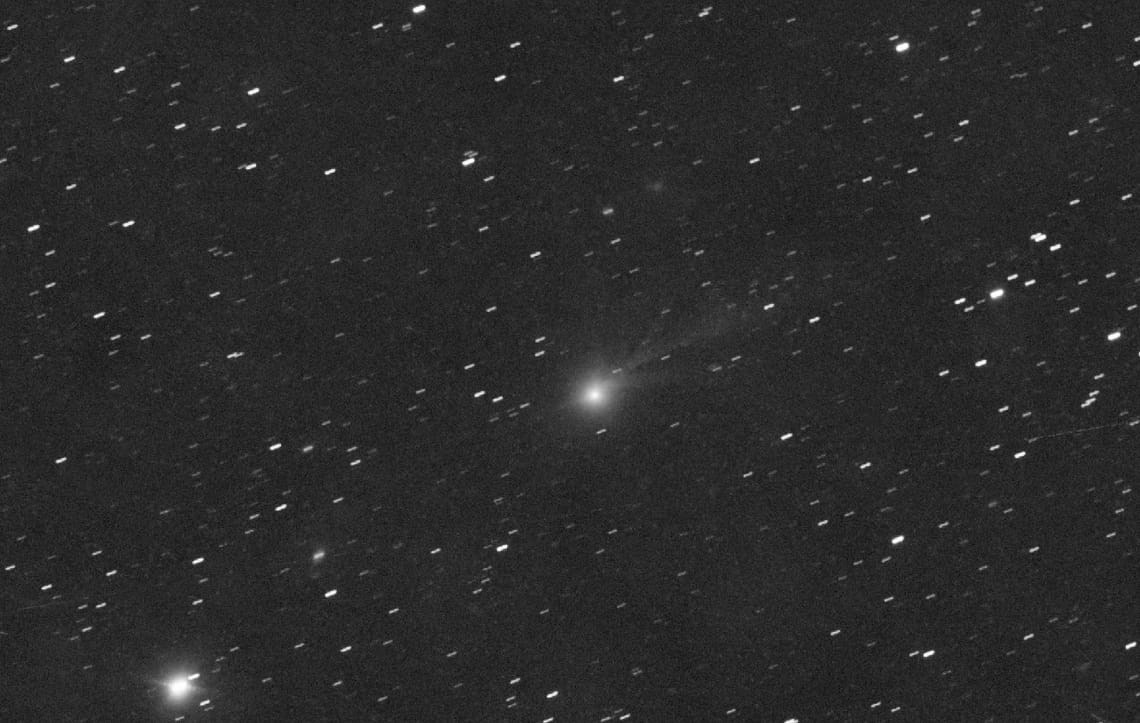
The composition of 3I/ATLAS’s tails is still uncertain; more observations are needed. Based on Jäger’s images, EarthSky suggested that this interstellar comet was likely altered by its recent close pass near the Sun (as often happens with comets).
Meanwhile, in his blog, Avi Loeb proposed a more unconventional idea: the jets observed on 3I/ATLAS might be linked to technological thrusters, raising the question of whether the comet has a natural or artificial origin.
November 5: Did 3I ATLAS change course?
When interstellar comet 3I/ATLAS passed close to the Sun, astronomers spotted a subtle but powerful effect: its light was bent by the Sun’s gravity.
According to calculations, light passing near the Sun should appear to shift by about 1.75 arcseconds — roughly the apparent width of a coin seen from 3 km away. Using space-based solar observatories, scientists measured almost the same value for 3I/ATLAS’s apparent position change as it moved past the Sun. This tiny deflection happens because massive objects like the Sun warp space around them, curving the paths of light that pass nearby.
Researchers also noted a small deviation in the comet’s trajectory as it left perihelion — about 4 arcseconds off from predictions. That shift is consistent with the combined effects of gravity and solar radiation pressure — not alien maneuvers, just physics doing its job.

November 4: 3I ATLAS color change puzzles scientists
The interstellar comet 3I/ATLAS appears to be changing color again. Recent images show the visitor turning to a bluish hue. Scientists say this sequence of color shifts is highly unusual for a comet and could signal evolving chemistry or dust dynamics.
Here’s what we know so far: when first observed, 3I/ATLAS appeared red. As it edged closer to the Sun, it turned green—possibly from newly released gases. Now, the shift toward blue may hint at yet another transformation, either within the dust/gas mix or from solar radiation altering its surface.
November 2: 3I/ATLAS is coming back into view
After swinging around the Sun, 3I/ATLAS is now heading back into darker skies and will start to reappear in the morning sky by mid-November.
It’s expected to shine around magnitude 11–12 — too faint for the naked eye, and only possibly visible in good binoculars under ideal dark-sky conditions, though small telescopes will show it more reliably.
If you want to try spotting it, look low above the eastern horizon just before sunrise. The comet will climb a bit higher each morning as it moves away from the Sun. Astronomers are now waiting for the first post-perihelion measurements to see whether this cosmic visitor will keep glowing brightly or begin to fade.
October 29: 3I/ATLAS survives its close pass to the Sun, suddenly brightening
The rare interstellar comet 3I/ATLAS has made it safely through its closest approach to the Sun, coming within 1.36 AU on October 29, 2025.
Observations from space telescopes — SOHO, STEREO-A, and GOES-19 — showed the comet brightening rapidly as it neared the Sun. Its glow reached about magnitude 9, but the comet was lost in the Sun’s glare and couldn’t be seen from Earth at the time.
Images taken by the spacecraft revealed something unexpected: 3I/ATLAS looked unusually blue. This color hints at strong gas activity, especially from molecules like C₂ and NH₂, shining in the comet’s thin atmosphere.
These emissions confirm that 3I/ATLAS behaves just like a natural comet, putting to rest early ideas that it might be an alien probe.
Read the full scientific paper on arXiv.
3I ATLAS news recap: September-late October 2025
It’s been a busy few months for our interstellar visitor. If you’ve lost track of this fast-moving interstellar drama — don’t worry. Here’s your quick catch-up on everything 3I/ATLAS has been up to lately:
- Sep 20: Astronomers spot a mysterious green glow around 3I/ATLAS — likely caused by unusual gases.
- Sep 23: New theory suggests 3I/ATLAS could be a “planet-forming seed,” a remnant that helps build worlds in young star systems.
- Sep 23: A solar storm is predicted to hit the comet — the first-ever such event involving an interstellar visitor.
- Sep 25: Avi Loeb notes the comet shows no non-gravitational acceleration and could be anomalously massive — or even propelled.
- Sep 28: Loeb links 3I/ATLAS to the legendary “Wow! Signal” from 1977, as the comet passes through the same region of the sky.
- Sep 29: The comet survives a solar storm unscathed, unlike many of its Solar System cousins.
- Sep 30: 3I/ATLAS slips behind the Sun, vanishing from view until late November.
- Oct 1: The comet approaches Mars, giving NASA orbiters and rovers a chance to observe it up close.
- Oct 5: A new Mars orbit photo confirms the comet’s faint glow.
- Oct 7: ESA’s ExoMars and Mars Express missions capture new images, showing the comet’s delicate coma.
- Oct 7: NASA’s Swift observatory detects water vapor — the first confirmed detection from an interstellar comet.
- Oct 19: Keck Observatory spots a rare anti-tail, appearing to point toward the Sun due to viewing geometry.
- Oct 21: As the comet hides behind the Sun, Loeb hints it could use the Oberth effect to change course unseen.
Comet 3I ATLAS live tracking: where is 3I ATLAS now, and how to see it
Want to catch a glimpse of a traveler from another star system? Comet 3I/ATLAS is passing through our cosmic neighborhood, and with the right timing and equipment, you can spot it for yourself. Below, we’ll walk you through how bright it will get, when and where to look, and how to avoid common pitfalls (like the glare of the Moon) to maximize your chances.
Comet 3I ATLAS brightening: what you’ll see?

When it was first discovered, the comet was extremely dim, shining at about magnitude 17. By September 2025, it had brightened into the magnitude 12–14. As 3I/ATLAS approached the Sun in late October, it surprised astronomers by brightening much faster than expected: it suddenly became visible to space observatories at magnitude 7–8. This outburst likely came from water ice becoming active as sunlight reached deeper layers beneath the surface — proof that 3I/ATLAS is far more dynamic than early models suggested.
Now, as it climbs back into the morning sky after solar conjunction, astronomers expect it to shine around magnitude 11–12 under normal conditions. However, some forecasts remain more optimistic, hinting that the comet could briefly reach about magnitude 9 if its heightened activity continues.
Either way, that would make 3I/ATLAS the brightest interstellar object ever observed, visible in small amateur telescopes.
When and where to see comet 3I/ATLAS?
The orbit of comet 3I/ATLAS lies almost in the plane of the planets (inclination ≈5° to the ecliptic), which means it can be observed from both hemispheres.
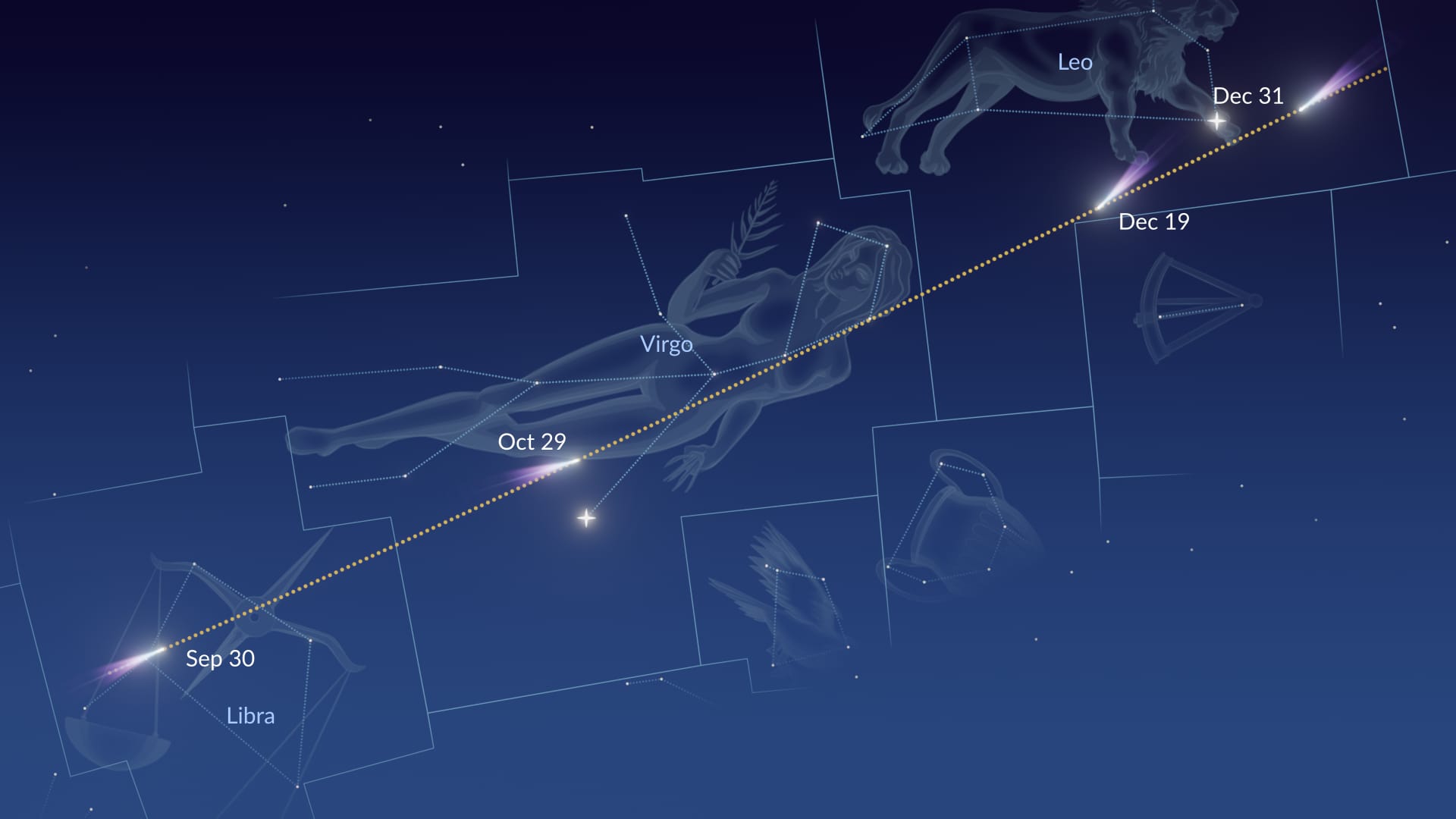
- November 2025: After solar conjunction, 3I/ATLAS will return to view in mid to late November. Around November 11, it may first appear in the morning sky before sunrise, though still low on the horizon. The best observing conditions will come in late November, as the comet climbs higher and becomes easier to spot in the dawn twilight.
- December 2025: 3I/ATLAS will move into the constellation Leo, still visible in the early morning hours. By then, however, its brightness will have dropped quickly to about magnitude 14 and fainter. As the year ends, the comet will drift away, leaving the Solar System behind.
Comet 3I/ATLAS observing tips: how to see it?
3I/ATLAS is expected to reach a peak brightness of magnitude 11–12 — too faint for regular binoculars, but within reach of small amateur telescopes (aperture 80–150 mm) under dark skies. Through the eyepiece, it will appear as a faint, diffuse glow. To see it at its best, plan carefully:
- Observe before dawn: about 90 minutes before sunrise in November, and up to 2 hours before sunrise in December.
- Find a dark site with a clear view toward the eastern horizon.
- Use low magnification (20–60×) to boost contrast and reveal the faint coma.
- Avoid bright moonlight. The Moon’s glare can easily wash out such a dim object, so aim for New Moon nights — November 19 and December 12. The Full Moon on December 4 (the last Supermoon of the year will make the comet nearly impossible to spot.
For convenient planning, see the Moon phase calendar on our website.
3I/ATLAS tracking: where is 3I ATLAS now?
Right now, the interstellar comet 3I/ATLAS is gliding through the constellation Virgo, steadily moving away from the Sun after its recent close approach. You can use the free Sky Tonight app as a comet tracker to pinpoint its exact location in the sky:
- Launch the app and tap the magnifying glass icon at the bottom of the screen;
- Type “3I ATLAS” into the search bar, then tap the blue target icon — the comet will appear on the sky map.
- Point your device toward the sky and simply follow the white arrow on the screen until it guides you to comet 3I/ATLAS above your location.
Frequently asked questions about the comet 3I/ATLAS
Why is comet 3I/ATLAS special?
To begin with, it’s a true interstellar object, meaning it didn’t form in our Solar System but came from another star system entirely. Such objects are incredibly rare, so each new one causes a stir. On top of that, early estimates suggest its core could be up to 5 kilometers across, making it one of the largest interstellar bodies we’ve ever spotted. And the best part is that this cosmic traveler will actually be visible in the sky this year.
Is comet 3I/ATLAS the only interstellar object found so far?
Nope! In fact, 3I/ATLAS is the third confirmed interstellar object to enter our Solar System. The very first was the oddly shaped object called ‘Oumuamua, discovered in 2017 — an elongated rock, which some thought looked like an alien spaceship. Then came 2I/Borisov in 2019, which behaved like a typical comet with a bright coma and tail.
How do we know that 3I/ATLAS is not from our Solar System?
Its unusual trajectory was the first big clue — it wasn’t closed, but had a hyperbolic shape, so astronomers suspected the comet wasn't local. Later, orbital calculations confirmed it: 3I/ATLAS is traveling at about 210,000 km/h, a speed typical of interstellar objects and far too high for something bound by the Sun’s gravity.
Will the comet 3I/ATLAS hit Earth?

No need to worry — comet 3I/ATLAS will pass through the inner part of our planetary system, but it will remain very far from Earth. Its closest approach to our planet will occur on December 19, 2025. The distance between the two bodies will be about 1.8 AU — that’s roughly 269 million km, nearly twice the average Earth–Sun distance.
When will 3I/ATLAS leave the Solar System?
After its closest approach to the Sun in late October 2025, 3I/ATLAS has begun its journey back into interstellar space. Traveling at around 30 km/s, it’s moving fast enough to escape the Sun’s gravity entirely. On its way out, the comet will reach perigee (closest to Earth) on December 19, 2025, and cross beyond Jupiter’s orbit by March 16, 2026. By the early 2030s, it will have left the planetary region of the Solar System — continuing its silent voyage through the galaxy, just as it once arrived.
Is 3I/ATLAS for sure a comet? Can it be an alien spaceship?
Most likely, 3I/ATLAS is a comet. It has an icy nucleus, produces gas and dust, and grows a coma and tail — textbook comet behavior (you can check our special article about comets and see for yourself). We might have hoped for alien friends, but not this time.
People want to believe, which is why so many ordinary things get mistaken for UFOs: from balloons to human-made satellites in the night sky. To help you out, we’ve collected the most common mix-ups in our infographic. Don’t let yourself be fooled!

31 ATLAS, 3AI ATLAS, ATLAS 3I, 3 Eye Atlas: what’s the correct name?
If you’ve seen people online calling it “31 ATLAS,” “3AI ATLAS,” or “3 Eye Atlas,” don’t worry — they all mean the same thing. The comet’s real designations are C/2025 N1 (ATLAS) and 3I/ATLAS, which may look different but refer to one and the same interstellar comet.
C/2025 N1 (ATLAS) is the comet’s provisional designation, following standard naming rules by the IAU:
- C/ — non-periodic comet.
- 2025 — the year of discovery.
- N1 — the first object discovered in the first half of July (the “N” period).
- ATLAS — the discovery project.
3I/ATLAS is the other designation, which also follows the IAU naming system, but emphasizes the comet’s interstellar nature:
- 3I shows it’s the third confirmed interstellar object (after 1I/‘Oumuamua and 2I/Borisov).
- ATLAS again refers to the discovery project.
So, C/2025 N1 (ATLAS) places the comet in the catalog of Solar System comets, while 3I/ATLAS emphasizes its unique status as an interstellar visitor. Both names are correct — they just tell the story from different angles.
Comet 3I/ATLAS discovery
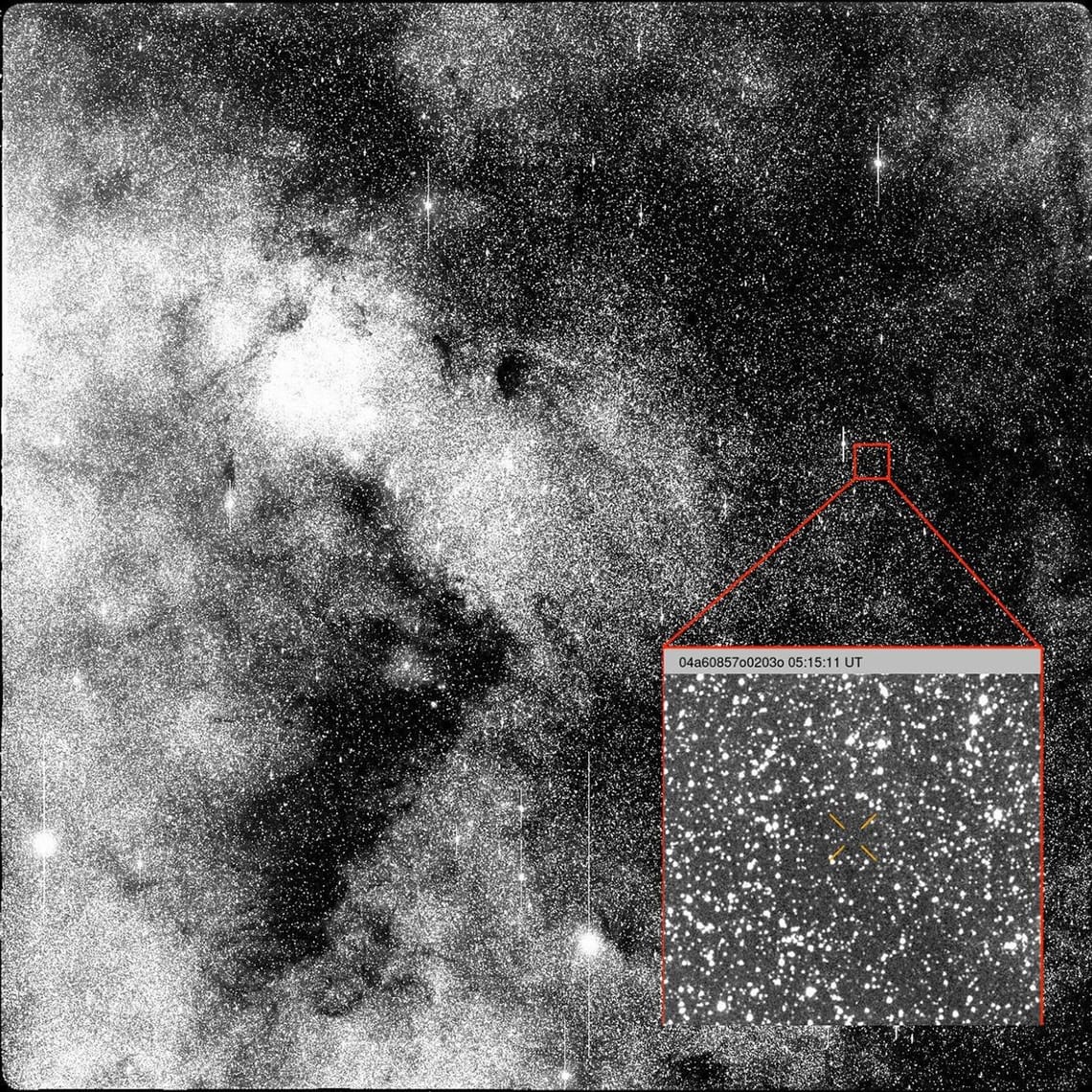
The comet was discovered on July 1, 2025, by an automated telescope of the ATLAS project in Chile, which was created to search for potentially hazardous asteroids. In the images, the object appeared as a very faint 20th-magnitude star, located about 4.5 billion kilometers from the Sun. Already the next day, calculations showed that its trajectory was not closed and had a hyperbolic shape. This meant the body had arrived from beyond the Solar System. On July 2, the Minor Planet Center officially confirmed its interstellar status.
Initially, the object was thought to be an asteroid, but subsequent observations revealed signs of cometary activity, including a small coma and a short tail. Over the following weeks, its brightness increased slowly, and it became clear that this was a full-fledged comet.
Why are interstellar comets like 3I/ATLAS so rare?
Most comets we see in the night sky belong to the Solar System. They were born billions of years ago in distant regions such as the Oort Cloud or Kuiper Belt and follow long, elliptical orbits around the Sun. Sometimes planetary gravity tweaks their paths, but they remain bound to our star.
An interstellar comet, however, has a completely different story. It forms in another planetary system and then receives such a strong gravitational “kick” from planets or passing stars that it is ejected forever. From that moment, it drifts through the galaxy for millions or even billions of years, until by sheer chance it passes through the Solar System. That chance is vanishingly small — which is why only three interstellar objects have been identified so far, with 3I/ATLAS among them.
Why do astronomers pay so much attention to interstellar objects?
Interstellar visitors like 3I/ATLAS are priceless to science because they act as natural messengers from other star systems. Unlike local comets, which were born in our own Solar System, these objects formed around entirely different stars and then wandered across the galaxy for millions or even billions of years before reaching us.
Studying them lets astronomers compare how planets and comets form under different conditions. Observations of 3I/ATLAS show that its composition most certainly includes water and carbon dioxide – the same ingredients we see in many Solar System comets. This suggests that the recipe for building comets, and perhaps even the raw materials for planets, may be surprisingly similar across the galaxy.
Comet 3I/ATLAS: to sum up
Comet 3I/ATLAS (C/2025 N1) is only the third interstellar object ever spotted in our Solar System, after ‘Oumuamua and 2I/Borisov. It’s large — with a nucleus estimated at 0.6–5.6 km across — and fast, racing along at about 210,000 km/h. While it won’t become visible to the naked eye, telescopes should reveal it at around magnitude 11-12 in late November 2025. Don’t miss your chance to track a messenger from another star system! With the free Sky Tonight app, you can find comet 3I/ATLAS in seconds, plan your observing sessions, and follow its journey across the constellations.
Visible right now: explore the other comets drawing everyone’s attention
Along with 3I/ATLAS, there are two more comets visible in the sky in November! Check our regularly updated article about the best comets to see right now to stay up to date with all the sky’s brightest travelers.
